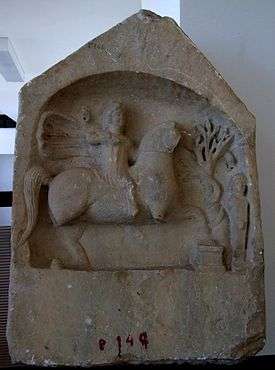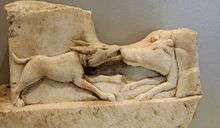Paleo-Balkan mythology

Paleo-Balkan mythology includes the religious practices of the Dacians, Thracians, and Illyrians. Little is known about the rituals and mythology of the Iron Age Balkans, but some of their gods are depicted in statuary or described in Greek sources.
One notable cult, attested from Thrace to Moesia and Scythia Minor, is that of the "Thracian horseman", also known as the "Thracian Heros", at Odessos (Varna) attested by a Thracian name as Heros Karabazmos, a god of the underworld usually depicted on funeral statues as a horseman slaying a beast with a spear.[1][2][3]
Daco-Thracian


Known Thracian deities include:
- Sabazios, the Thracian reflex of Indo-European Dyeus, identified with Heros Karabazmos, the "Thracian horseman". He gained a widespread importance especially after the Roman conquest. This could be akin to Sleipnir, the horse ridden by Odin, in Norse mythology. After Christianity was adopted, the symbolism of Heros continued as representations of Saint George slaying the dragon (compare Uastyrdzhi/Tetri Giorgi in the Caucasus).[2]
- Zibelthiurdos (also "Zbelsurdos", "Zibelthurdos"): a god recognized as similar to the Greek Zeus as a wielder of lightning and thunderbolts.
- Kotys ("Cotys", "Cotto", "Cottyto", "Cottytus"), a goddess worshipped with much revelry by Thracian tribes such as the Edonians in the festival Cotyttia.[4] A cult of Cottyto existed in classical Athens. According to Greek sources her priests were called baptes or "washers" because their pre-worship purification rites involved bathing. Her worship included midnight orgies (orgia). Her name is believed to have meant "war, slaughter", akin to Old Norse Höðr "war, slaughter".[5]
Several Thracian deities show close analogy to the Greek cult of Dionysus, Orpheus and Persephone (the Dionysian Mysteries):
- Bendis was a Thracian goddess of the moon and the hunt[6] whom the Greeks identified with Artemis, and hence with the other two aspects of formerly Minoan goddesses, Hecate and Persephone.
- Semele is probably the Mother Earth goddess akin to Lithuanian Zemyna and Latvian Semes, both of which are 'Mother Earth' goddesses. Likely there has been an early Semele Goddess in proto-Slavic mythology as 'earth' to this day is "земля" (semlya) in Russian and "земя" (zemya) in Bulgarian. Also compare Phrygian 'Zemelo'.
Known Dacian theonyms include:
- Zalmoxis, identified by some with the thunder-god Gebeleïzis,[7] an important god of the Dacians[8] and Thracians.[9]
- Derzelas (also "Darzalas") was a chthonic god of health and human spirit's vitality.
Kogaionon was the name of a holy mountain of the Dacians.
Illyrian
The mythology of the Illyrians is only known through mention of Illyrian deities on Roman period monuments, some with interpretatio Romana.[10] There appears to be no single most prominent Illyrian god and there would have been much variation between individual Illyrian tribes. The Illyrians did not develop a uniform cosmology on which to center their religious practices.[11]
Some deities are known exclusively from Istria,[12] such as Eia, Malesocus, Boria and Iria. In Liburnia, Anzotica is identified with Venus. Other local theonyms[13] include Latra, Sentona and Ica. Bindus, identified with Neptune, was worshipped among the Japodes.[14] Further north, the hot springs of Topusko[15] were dedicated to Vidasus and Thana, identified with Silvanus[16] and Diana. From the eastern Balkans, the cult of the Thracian horseman spread to Illyria during the early centuries CE. The god Medaurus[17] mentioned in a dedication at Lambaesis in Africa by a Roman senator and native of Risinium appears to be identical to the horseman, being described as riding on horseback and carrying a lance. The Delmatae had Armatus as a god of war.[18] The god En was also worshipped by Illyrians.[19] En was demoted to demonic status following the arrival of Christianity in Illyria, and continues to be used in the Albanian language to refer to Thursday (Albanian: Enjte).[19]
See also
| Wikimedia Commons has media related to Dacian and Dacians. |
Notes
- ↑ Lurker, Manfred (1987). Dictionary of Gods and Goddesses, Devils and Demons. p. 151.
- 1 2 Nicoloff, Assen (1983). Bulgarian Folklore. p. 50.
- ↑ Isaac, Benjamin H. (1986). The Greek Settlements in Thrace Until the Macedonian Conquest. p. 257.
- ↑ Detschew, Dimiter. Die Thrakische Sprachreste. Wien, 1957: p. 258 (in German)
- ↑ Also cognate: Irish cath "war, battle", early German Hader "quarrel", Greek kótos "hatred", Old Church Slavonic kotora "fight, brawl", Sanskrit śatru "enemy, nemesis", and Hittite kattu "spiteful". See Orel, Vladimir. A Handbook of Germanic Etymology. Leiden, Netherlands: Brill, 2003: 165.
- ↑ Theoi Project - Bendis
- ↑ Hdt. 4.94, Their belief in their immortality is as follows: they believe that they do not die, but that one who perishes goes to the deity Salmoxis, or Gebeleïzis, as some of them call him.
- ↑ Harry Thurston Peck, Harpers Dictionary of Classical Antiquities (1898),(Zalmoxis) or Zamolxis (Zamolxis). Said to have been so called from the bear's skin (zalmos) in which he was clothed as soon as he was born. He was, according to the story current among the Greeks on the Hellespont, a Getan, who had been a slave to Pythagoras in Samos, but was manumitted, and acquired not only great wealth, but large stores of knowledge from Pythagoras, and from the Egyptians, whom he visited in the course of his travels. He returned among the Getae, introducing the civilization and the religious ideas which he had gained, especially regarding the immortality of the soul. Herodotus, however, suspects that he was an indigenous Getan divinity ( Herod.iv. 95)
- ↑ XCV. This Zamolxis, as I have been informed by those Greeks who inhabit the Hellespont and the Euxine, was himself a man, and formerly lived at Samos, in the service of Pythagoras, son of Mnesarchus; having obtained his liberty, with considerable wealth, he returned to his country. Here he found the Thracians distinguished equally by their profligacy and their ignorance; whilst he himself had been accustomed to the Ionian mode of life, and to manners more polished than those of Thrace; he had also been connected with Pythagoras, one of the most celebrated philosophers of Greece. He was therefore induced to build a large mansion, to which he invited the most eminent of his fellow-citizens: he took the opportunity of the festive hour to assure them, that neither himself, his guests, nor any of their descendants, should ever die, but should be removed to a place, where they were to remain in the perpetual enjoyment of every blessing. After saying this, and conducting himself accordingly, he constructed a subterranean edifice: when it was completed, he withdrew himself from the sight of his countrymen, and resided for three years beneath the earth.—During this period, the Thracians regretted his loss, and lamented him as dead. In the fourth year he again appeared among them, and by this artifice gave the appearance of probability to what he had before asserted. XCVI. To this story of the subterraneous apartment, I do not give much credit, though I pretend not to dispute it; I am, however, very certain that Zamolxis must have lived Many years before Pythagoras : whether, therefore, he was a man, or the deity of the Getse, enough has been said concerning him. These Getse, using the ceremonies I have described, after submitting themselves to the Persians under Darius, followed his army. - Herodotus page 117 Published by P.P. Berresford, 1828
- ↑ Wilkes, J.J. The Illyrians, 1992, p. 245, ISBN 0-631-19807-5. "...Illyrian deities are named on monuments of the Roman era, some in equation with gods of the classical pantheon (see figure 34)."
- ↑ Wilkes. "Unlike Celts, Dacians, Thracians or Scythians, there is no indication that Illyrians developed a uniform cosmology on which their religious practice was centred. An etymology of the Illyrian name linked with serpent would, if it is true, fit with the many representations of..."
- ↑ Wilkes. "...dominant Illyrian deity and some were evidently worshipped only in particular regions. Thus several deities occur only in Istria, including Eia, Malesocus, Boria and Iria. Anzotica was the Liburnian Venus and appears in the traditional image of the classical goddess."
- ↑ Wilkes. "Other local deities were Latra, Sentona and the nymph Ica, praying in relief sculpture), Knez 1974 (ritual vessel), Baçe 1984 (temple architecture in Illyrian Albania)."
- ↑ Wilkes. "...including altars dedicated by chiefs of the Japodes at the shrine of Bindus Neptunus at a spring near Bihaé (see figure 30). The first reported contact between Japodes and Romans occurred..."
- ↑ Wilkes. "North of the Japodes, the altars to Vidasus and Thana dedicated at the hot springs of Topusko reveal the local Roman Illyrians..."
- ↑ Wilkes. "...identities of Silvanus and Diana, a familiar combination on many dedications in the territory of the Delmatae."
- ↑ Wilkes. "...the short cloak streaming out behind. The Illyrian town Rhizon (Risinium) on the Gulf of Kotor had its protective deity Medaurus..."
- ↑ Wilkes. "...Armatus at Delminium (Duvno) who was evidently a war god of the Delmatae, and the Latin Liber who appears with the..."
- 1 2 Lurker, Manfred. The Routledge Dictionary of Gods and Goddesses, Devils and Demons, Taylor & Francis e-Library, 2005. p. 57.
References
- Wilkes, John. The Illyrians. Blackwell, 1992.
- Tacheva, Margarita. Eastern Cults in Moesia Inferior and Thracia (5th Century BC-4th Century AD), 1983, ISBN 90-04-06884-8.